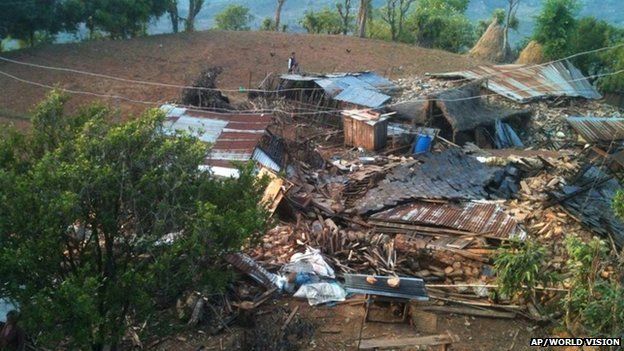Rural Nepal Angry With Slow Aid: More Than 70,000 Houses Destroyed:
2.8 Million People Displaced
By Countercurrents.org
30 April, 2015
Countercurrents.org

Anger, frustration and tension are growing in parts of rural Nepal over the slow pace of relief efforts. Kathmandu also found protests over bus arrangement for going back to rural homes. Badly-affected villages are yet to receive any assistance. Survivors broke into government offices in Dolakha district to demand relief supplies. Survivors confronted prime minister Sushil Koirala in a Kathmandu hospital. There are long queues for food and water around Kathmandu.
Official death figure during afternoon of 30 April 2015 reached more than 5,500 people, and injured at least 11,000. Only 14 survivors have been saved from the rubble till now.
Media reports said:
Nepal’s prime minister Sushil Koirala was confronted by survivors desperate for relief deliveries when he visited a hospital in Kathmandu. Many survivors gathered in front of the prime minister to request to water, food and tents.
About 200 people blocked traffic in Kathmandu after many faced huge queues for free bus rides out of the city. The protesters confronted police and there were minor scuffles. But no arrests were made.
Thousands waited at bus stations in Kathmandu, hoping to reach their hometowns in rural areas. Some wanted to check on the fate of family and loved ones in the quake, while others were fearful of more aftershocks in the city.
Buses to take people from Kathmandu to their homes in rural areas are crammed to capacity. Thousands were waiting for buses to take them to rural areas. "We've been left starving in the cold and the best this government can give us is this queue," said one resident, Rajana, as she queued for a bus to her home village.
Some people have decided to return to their homes, having spent several nights in the open. Cash machines have been refilled and some shops and street vendors have once again started trading.
Aid is beginning to reach remote districts for the first time. However, the Nepalese government has acknowledged “weaknesses” in the aid operation. The government says it has been overwhelmed by the disaster. The aid distribution process remains fairly chaotic, with Nepalese officials having difficulty directing the flow of emergency supplies.
Survivors in some areas were angry that neither food nor medicine has reached them.
Hospitals’ capacity has been overwhelmed forcing many people to be treated on roads. “Managing dead bodies has been challenging and surgical facilities are overwhelmed. Many hospitals near Kathmandu have reportedly run out of medicines. Diarrhoea is already an issue in the Kathmandu valley.” Fuel is urgently needed to pump ground water and maintain hospital services.
In several villages north-east of Kathmandu, no buildings have been left untouched and bodies are still lying under the rubble.
There has been no help from the government or aid agencies even though supplies could easily be brought in by road or by helicopter.
Some villages were devastated by the quake. There have been urgent appeals for food, water - and shelter
"We will die if there is no help from the government or other organizations," said Dhan Bahadur Shresta, a resident of Deupur Sipaghat Kavre village. "We will starve to death and could get diseases like cholera and dysentery and there could be an epidemic."
Some helicopter crews who have managed to land in isolated communities have been faced with desperate villagers pleading to be airlifted to safety.
In the village of Sangachowk, angry villagers blocked the main road with tyres and stopped trucks of rice and other aid headed for other areas.
The villagers also reportedly blocked a convoy of army trucks loaded with relief supplies, leading to a tense standoff with armed soldiers.
There were more angry scenes in Dolakha, east of Kathmandu, when residents smashed the windows of a local administrative building.
The Chief District Officer Prem Lal Lamichhane said: "Over 200,000 people are homeless. We've been told that materials are on their way, but we haven't received them yet."
Heavy rain has intensified the hardships for the countless Nepalis sleeping out in the open as their homes were destroyed or they don't feel safe inside buildings amid continuing aftershocks.
People have started leaving tents set up in areas in Kathmandu.
4.2 million need urgent food
The UN has appealed for $415m to help provide emergency relief over the next three months. The UN says more than eight million people have been affected and some 70,000 houses have been destroyed by Saturday's quake. The figure may rise. An estimate 2.8 million people have been displaced by the earthquake, as hundreds of thousands of people are afraid to return to their homes.
An estimated 4.2 million people are in urgent need of water, sanitation and hygiene support. Some 3.5 million people need food assistance, including 1.4 million in need of priority assistance.
The UN appeal also raises the issue of weak government and accountability in Nepal.
The appeal says: Coming days and weeks will need civil-military coordination, joint response planning, assessments, relief distribution and information management to facilitate safe, secure and timely access to people in need. Engagement with affected communities is essential. Given local government capacity challenges and weak accountability mechanisms locally where election have not been held since 2002 due to the post-war transition, bolstering humanitarian accountability mechanisms will be essential to control.
Half a million tents are urgently needed for the huge number of people forced from their homes by the earthquake, said a government minister.
Despite extensive damage, experts say the number of casualties in many villages was lower than feared because people were working outdoors at the time the quake struck.
Tags
.
Comments are moderated

